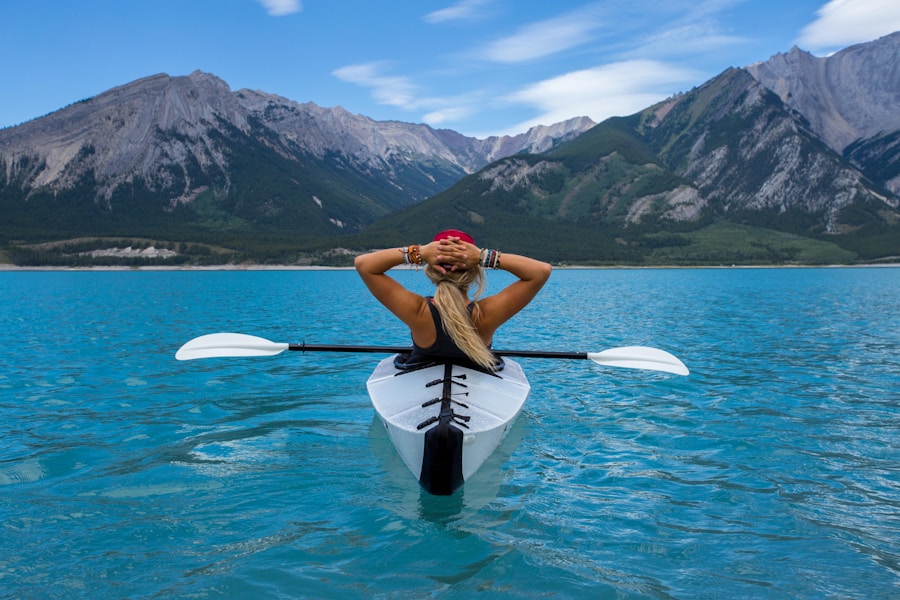
Get Ready to Make a Splash: Catch the Canoeing Action at the World Championships!
Introduction to the World Canoeing Championships
The World Canoeing Championships is one of the most prestigious events in the world of canoeing. It brings together the best athletes from around the globe to compete in various disciplines, including sprint, slalom, and paracanoe. The championships serve as a platform for these athletes to showcase their skills and compete for the title of world champion.
The importance of the World Canoeing Championships cannot be overstated. It is a chance for athletes to prove themselves on the international stage and establish their dominance in the sport. The championships also provide an opportunity for countries to showcase their talent and promote the sport of canoeing within their borders. Additionally, the event attracts a large audience, both in person and through television and online streaming, further increasing the visibility and popularity of canoeing.
History of Canoeing as a Competitive Sport
Canoeing has a long and rich history as a competitive sport. It originated as a means of transportation and hunting for indigenous peoples around the world. However, it wasn’t until the late 19th century that canoeing began to be recognized as a sport.
The first recorded canoe race took place in 1869 in England, where two men raced each other on the River Thames. This marked the beginning of organized canoeing competitions. Over time, canoeing evolved into a more structured sport, with standardized rules and regulations.
Major milestones in the history of canoeing championships include the establishment of the International Canoe Federation (ICF) in 1924, which became the governing body for the sport. The ICF introduced the first World Championships in 1938, which were held in Prague, Czechoslovakia. Since then, the championships have been held annually (with some exceptions) and have grown in size and significance.
Top Athletes to Watch Out for in the Championships
The World Canoeing Championships attract some of the most talented and accomplished athletes in the sport. Here are a few athletes to watch out for in the upcoming championships:
1. Lisa Carrington (New Zealand) – Carrington is a dominant force in sprint canoeing. She has won multiple Olympic gold medals and World Championships titles in the women’s kayak events. Her speed and power make her a formidable competitor.
2. Jessica Fox (Australia) – Fox is a world-class slalom canoeist. She has won numerous World Championships titles and Olympic medals in the women’s kayak and canoe events. Her technical skills and precision make her a strong contender in any competition.
3. Curtis McGrath (Australia) – McGrath is a paracanoeist who has achieved remarkable success in his sport. He is a multiple-time World Champion and Paralympic gold medalist. His determination and resilience make him an inspiration to many.
These athletes have proven themselves time and again on the international stage, and it will be exciting to see how they perform in the World Canoeing Championships.
The Different Disciplines of Canoeing: Sprint, Slalom, and Paracanoe
Canoeing encompasses several different disciplines, each with its own unique characteristics and challenges. The three main disciplines are sprint, slalom, and paracanoe.
Sprint canoeing involves racing on flatwater over distances ranging from 200 meters to 1,000 meters. Athletes compete in kayaks or canoes, either individually or in teams. The focus is on speed and power, with athletes paddling as fast as possible to reach the finish line.
Slalom canoeing takes place on whitewater courses with gates that athletes must navigate through while paddling downstream. The goal is to complete the course in the fastest time possible without touching or missing any gates. Slalom requires a combination of technical skill, agility, and strength.
Paracanoe is a discipline specifically for athletes with physical disabilities. It follows the same rules as sprint canoeing, but with adaptations to accommodate different impairments. Paracanoe provides an opportunity for athletes with disabilities to compete at the highest level and showcase their abilities.
Notable athletes in each discipline include Lisa Carrington and Jessica Fox in sprint and slalom, respectively. In paracanoe, Curtis McGrath has been a dominant force in recent years.
How to Train for Canoeing: Tips from the Pros
Training for canoeing requires a combination of strength, endurance, and technique. Professional canoeists follow rigorous training programs to prepare themselves for competition. Here are some tips from the pros on how to train for canoeing:
1. Build strength: Canoeing requires upper body strength, especially in the shoulders, arms, and core. Strength training exercises such as weightlifting, pull-ups, and push-ups can help build the necessary muscle.
2. Improve endurance: Canoeing races can be physically demanding, so it’s important to have good cardiovascular endurance. Incorporate activities like running, cycling, or swimming into your training routine to improve your stamina.
3. Work on technique: Canoeing is not just about brute strength; technique plays a crucial role in performance. Practice proper paddling technique, including the catch, power phase, and recovery. Seek guidance from experienced coaches to refine your technique.
For beginners who want to start training for canoeing, it’s important to start slowly and gradually increase intensity and duration. Focus on building a solid foundation of strength and endurance before diving into more advanced training techniques.
Challenges and Obstacles Faced by Canoeists in the World Championships
Competing in the World Canoeing Championships presents numerous challenges for athletes. Both physical and mental challenges must be overcome in order to perform at their best.
Physically, canoeists face the demands of intense training and competition. The races require a high level of fitness and strength, and athletes must be able to maintain their performance over multiple rounds. Fatigue can set in, making it difficult to maintain proper technique and speed.
Mentally, the pressure of competing on the world stage can be overwhelming. Athletes must be able to handle the stress and anxiety that comes with high-stakes competition. They must also be able to stay focused and maintain a positive mindset, even in the face of setbacks or mistakes.
In addition to these challenges, canoeists may also face difficult conditions during the championships. This could include adverse weather conditions, strong currents or waves, or challenging whitewater courses. Athletes must be adaptable and able to adjust their strategy and technique to suit the conditions.
Strategies for overcoming these challenges include mental preparation techniques such as visualization and positive self-talk. Physical preparation through proper training and conditioning is also crucial. Having a strong support system, including coaches, teammates, and family, can provide the necessary encouragement and motivation.
The Role of Technology in Canoeing: From Equipment to Training Methods
Technology has played a significant role in the development of canoeing as a sport. Advancements in equipment have improved performance and safety for athletes. Canoes and kayaks are now made from lightweight materials that enhance speed and maneuverability. Paddles have also been designed to maximize efficiency and reduce strain on the body.
In addition to equipment advancements, technology has also impacted training methods in canoeing. Data analysis tools allow coaches and athletes to track performance metrics such as stroke rate, speed, and power output. This data can be used to identify areas for improvement and optimize training programs.
Video technology has also become an integral part of training in canoeing. Athletes can review footage of their races or practice sessions to analyze their technique and identify areas for improvement. Coaches can provide feedback and guidance based on this analysis, helping athletes refine their skills.
Overall, technology has revolutionized the sport of canoeing, making it more accessible and enabling athletes to reach new levels of performance.
The Importance of Nutrition and Hydration in Canoeing
Proper nutrition and hydration are essential for optimal performance in canoeing. Canoeists have high energy demands due to the physical nature of the sport, and they must fuel their bodies adequately to meet these demands.
A balanced diet that includes a variety of nutrient-rich foods is important for canoeists. Carbohydrates provide the primary source of fuel for muscles during exercise, so it’s important to consume enough carbohydrates to maintain energy levels. Protein is also crucial for muscle repair and recovery. Healthy fats, vitamins, and minerals are necessary for overall health and performance.
Hydration is equally important for canoeists. Dehydration can lead to decreased performance, fatigue, and increased risk of injury. Athletes should aim to drink enough fluids throughout the day to stay properly hydrated. During training and competition, it’s important to drink fluids regularly to replace lost sweat.
Tips for maintaining a healthy diet and staying hydrated include planning meals and snacks in advance, incorporating a variety of fruits and vegetables into your diet, and carrying a water bottle with you at all times.
Spectator Experience: Where to Watch the World Championships Live
The World Canoeing Championships offer an exciting experience for spectators who want to witness the action firsthand. The location of the championships varies each year, but they are typically held in venues that provide excellent viewing opportunities.
If you’re interested in attending the event as a spectator, it’s important to plan ahead. Check the official website of the championships for information on the location, schedule, and ticket availability. Some venues may require advanced ticket purchase or have limited seating capacity.
For those who are unable to attend in person, there are options for watching the championships online or on T
Many broadcasters provide live coverage of the event, allowing fans to follow the action from the comfort of their own homes. The official website of the championships may also offer live streaming options.
Conclusion: Why Canoeing is a Thrilling and Exciting Sport to Watch and Participate In.
Canoeing is a thrilling and exciting sport that offers something for everyone. Whether you’re a fan watching the World Canoeing Championships or an aspiring athlete looking to get involved, canoeing has a lot to offer.
The World Canoeing Championships bring together the best athletes from around the world, showcasing their skills and pushing the boundaries of what is possible in the sport. The championships provide a platform for these athletes to compete at the highest level and establish themselves as world-class competitors.
Canoeing itself is a unique and exciting sport. It combines elements of strength, endurance, technique, and strategy, making it a true test of athleticism. The different disciplines of canoeing offer a variety of challenges and opportunities for athletes to excel.
If you’re interested in getting involved in canoeing, whether as a participant or spectator, there are plenty of resources available to help you get started. Local clubs and organizations can provide information on training programs and events in your area. Watching the World Canoeing Championships can also be a great way to learn more about the sport and get inspired.
In conclusion, canoeing is a sport that captivates both athletes and spectators alike. Its rich history, top athletes, and thrilling competitions make it an exciting sport to watch and participate in. So why not dive in and experience the excitement of canoeing for yourself?





